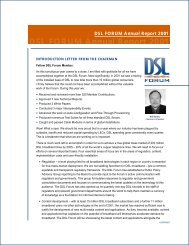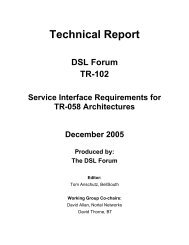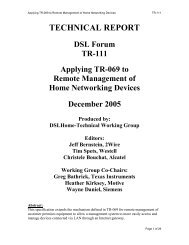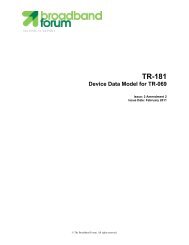MPLS in Mobile Backhaul Networks Framework and Requirements ...
MPLS in Mobile Backhaul Networks Framework and Requirements ...
MPLS in Mobile Backhaul Networks Framework and Requirements ...
You also want an ePaper? Increase the reach of your titles
YUMPU automatically turns print PDFs into web optimized ePapers that Google loves.
<strong>MPLS</strong> <strong>in</strong> <strong>Mobile</strong> <strong>Backhaul</strong> <strong>Networks</strong> <strong>Framework</strong> <strong>and</strong> <strong>Requirements</strong> Technical Specification IP/<strong>MPLS</strong> Forum 20.0.0<br />
___________________________________________________________________________________<br />
synchronized accord<strong>in</strong>g to it (e.g. <strong>in</strong> case of an <strong>in</strong>door operation). The external reference synchronization<br />
signals need to <strong>in</strong>corporate both accurate frequency <strong>and</strong> time.<br />
Under all circumstances, the relative phase difference of the synchronization signals at the <strong>in</strong>put port of<br />
any Node B <strong>in</strong> the synchronized area shall not exceed 2.5 usec. This requirement translates to an<br />
equivalent maximum phase difference compared to UTC requirement of less than 1.25 usec (half the 2.5<br />
usec budget).<br />
(iii) Transport Channel Synchronization:<br />
The Transport Channel (or L2) synchronization provides a L2 common frame number<strong>in</strong>g between<br />
UTRAN <strong>and</strong> UE (frame synchronization between the L2 entities). It def<strong>in</strong>es synchronization of the frame<br />
transport between RNC <strong>and</strong> Node B, consider<strong>in</strong>g radio <strong>in</strong>terface tim<strong>in</strong>g. DL TBS (Transport Block Set)<br />
transmission is adjusted to fit receiver by adjust<strong>in</strong>g the DL TBS tim<strong>in</strong>g <strong>in</strong> the upper node. UL TBS<br />
transmission is adjusted by mov<strong>in</strong>g the UL reception w<strong>in</strong>dow tim<strong>in</strong>g <strong>in</strong>ternally <strong>in</strong> the upper node.<br />
(iv) Radio Interface Synchronization:<br />
The Radio Interface synchronization relates to the tim<strong>in</strong>g of the radio frame transmission (either <strong>in</strong> DL<br />
[FDD] or <strong>in</strong> both directions [TDD]). FDD <strong>and</strong> TDD have different mechanisms to determ<strong>in</strong>e the exact<br />
tim<strong>in</strong>g of the radio frame transmission <strong>and</strong> also different requirements on the accuracy of the tim<strong>in</strong>g.<br />
In FDD Radio Interface synchronization is necessary to assure that the UE receives radio frames<br />
synchronously from different cells, <strong>in</strong> order to m<strong>in</strong>imize UE buffers.<br />
In TDD Radio Interface synchronization refers to the follow<strong>in</strong>g two aspects:<br />
Inter-cell Synchronization that is used to synchronize radio frames with<strong>in</strong> neighbor<strong>in</strong>g cells <strong>in</strong> order to<br />
m<strong>in</strong>imize cells cross-<strong>in</strong>terferences, to allow frame<br />
END OF DOCUMENT<br />
October 2008 Page 40
















